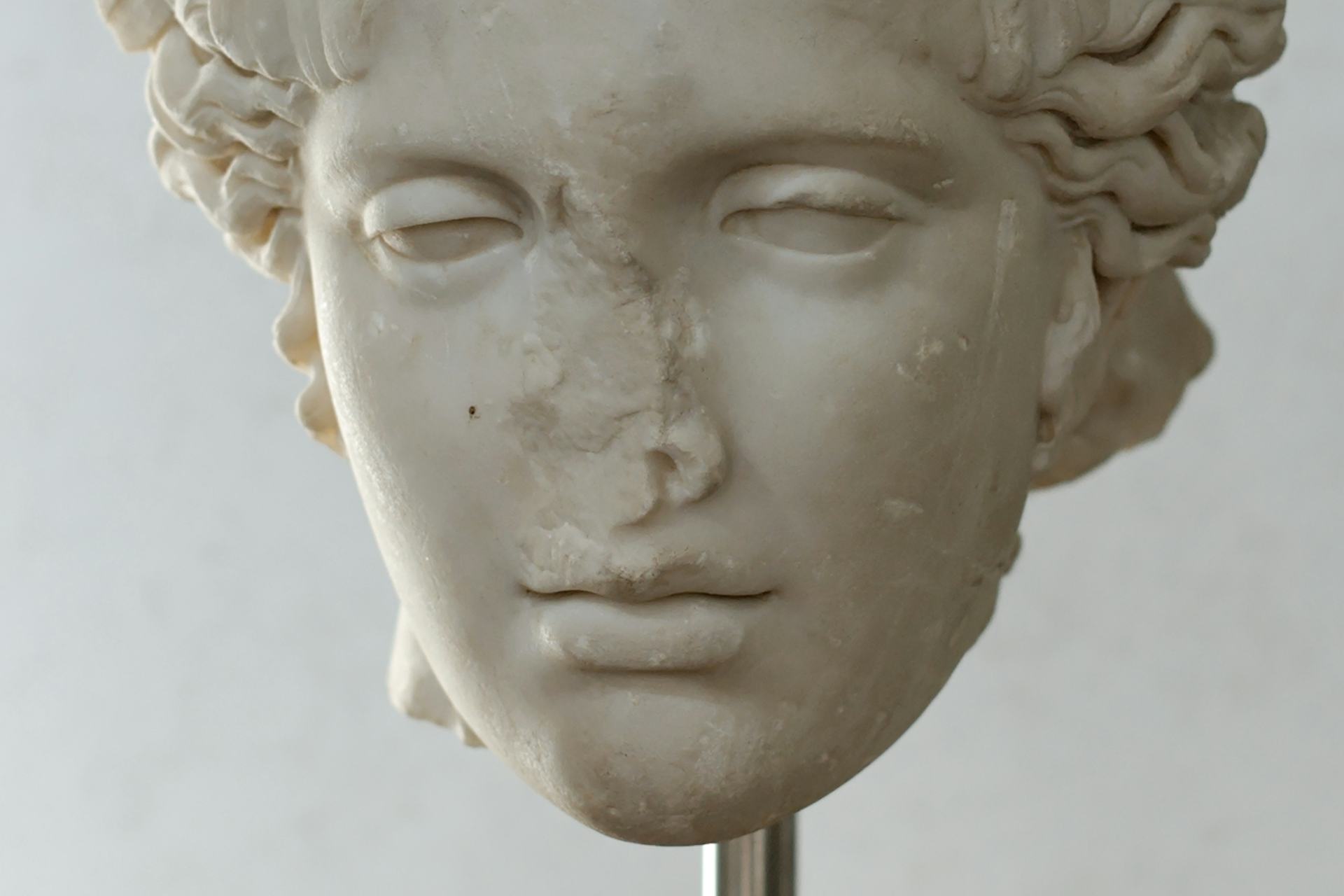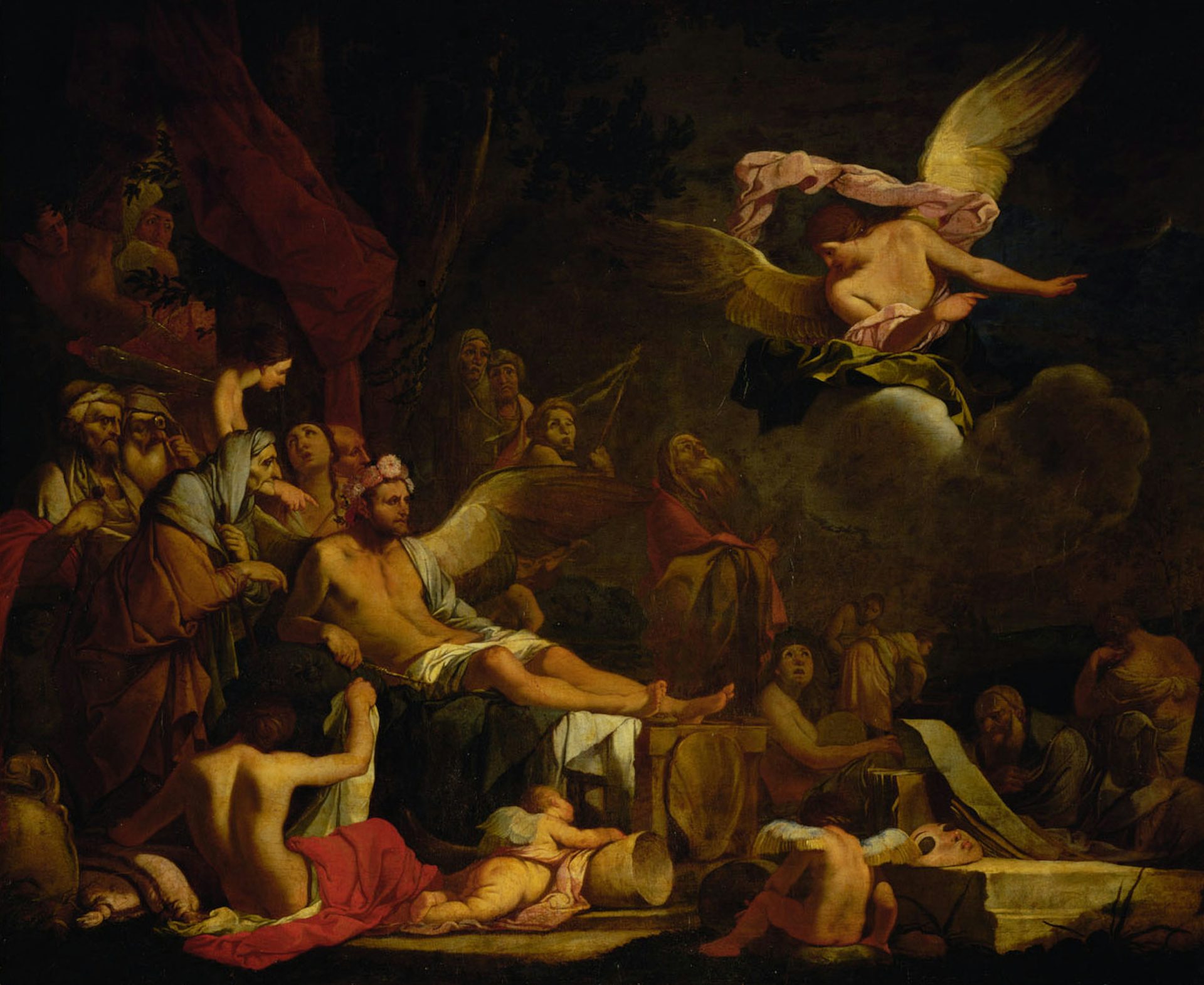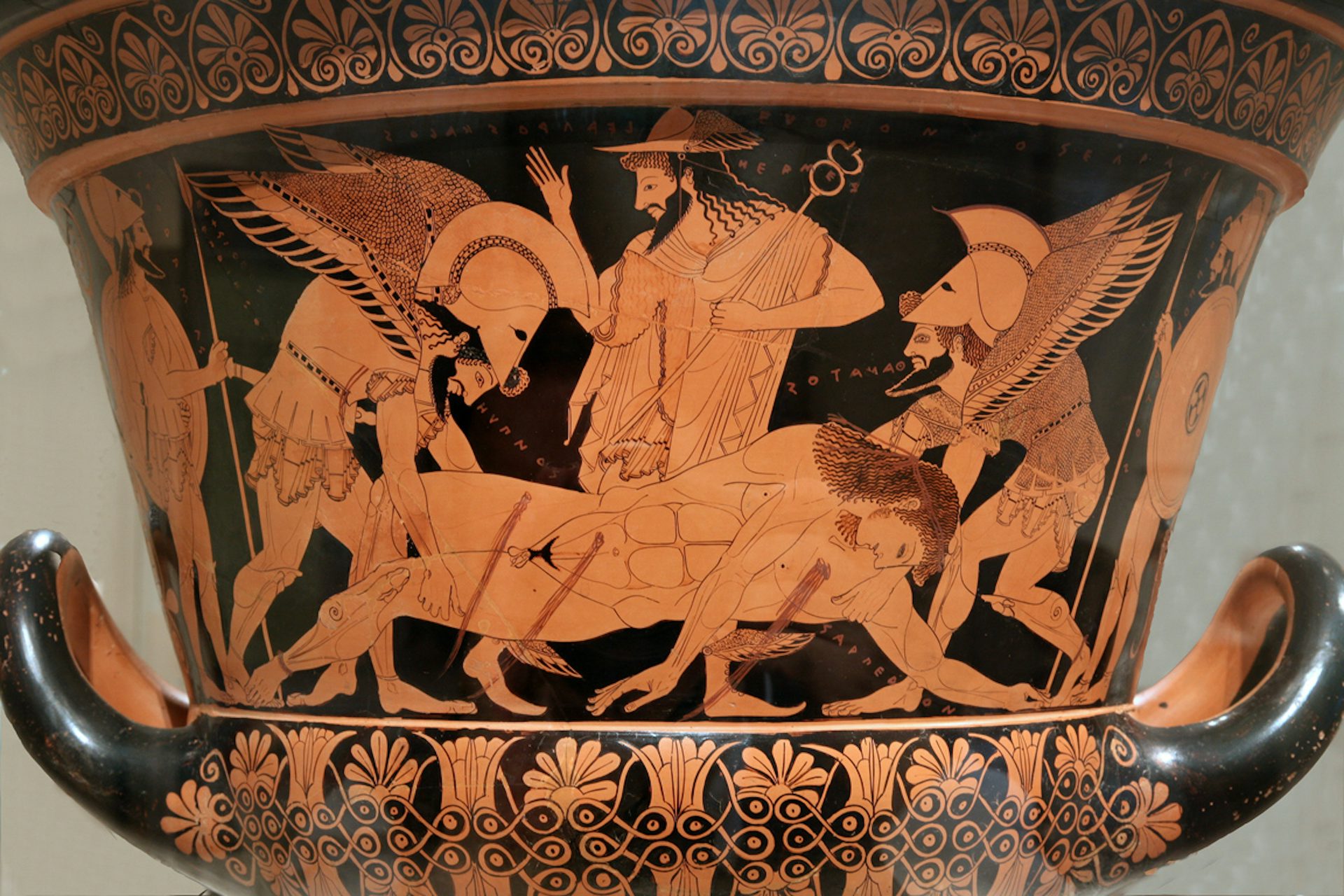Hypnos

Marble statue of Hypnos from Hadrian’s Villa in Tivoli (second century CE)
Palazzo Massimo, Rome / JastrowPublic DomainOverview
Gentle Hypnos, child of Nyx, was a Greek deity who personified sleep. He was most often imagined as a benevolent god, bringing peaceful sleep to all living things. But there was a darker side to Hypnos: the god of sleep was also associated with death. Indeed, Thanatos—the personification of death—was his twin brother. Poets and artists loved to create lavish, imaginative portraits of Hypnos and his remote, dreamy home. But despite his power and renown, there was no real cult of Hypnos in the ancient world.
Etymology
The name “Hypnos” (Greek ῞Υπνος, translit. Hýpnos) is the Greek word for “sleep.” It is ultimately derived from the Proto-Indo-European *sup-no-, also meaning “sleep.”[1]
In Roman culture, Hypnos was called Somnus or Sopor (Latin words for “sleep”).
Pronunciation
English
Greek
Hypnos ῞Υπνος (Hýpnos) Phonetic
IPA
[HIP-nos] /ˈhɪp nɒs/
Attributes
Functions and Characteristics
Hypnos was the god or daemon who personified sleep. He was responsible for bringing sleep to all living things, both mortal and immortal. He was thus regarded as an extremely powerful deity.[2]
Gentle Hypnos was typically described as handsome, youthful,[3] and winged (his wings, at least in some accounts, were said to grow out of his temples).[4] According to the poet Hesiod, he “roam[ed] peacefully over the earth and the sea’s broad back and [was] kindly to men.”[5]
The god would typically approach people from the air and could induce sleep using any number of attributes: his wings,[6] a twig,[7] a wand dipped in the waters of the River Lethe,[8] or a horn filled with sleep-inducing drugs.[9] He could also bring sleep to gods or mortals by covering them with a veil,[10] or even with his mere presence.[11]
There were two sides to Hypnos. On the one hand, he was a gentle, kindly force—the embodiment of sweet sleep[12] and a liberator from care and anxiety.[13] On the other hand, Hypnos was closely connected with death—Thanatos, death personified, was his twin brother, after all—and he could therefore be menacing.[14] Moreover, as the bringer of dreams, Hypnos was sometimes viewed as a deceptive god.[15]
In addition to his mother Nyx (“Night”) and his twin brother Thanatos (“Death”), Hypnos had a number of close associates among the gods. The Oneiroi (“Dreams”), for example, were sometimes described as his subjects.[16] In some later accounts, he was said to be a follower of Dionysus.[17] He was also occasionally imagined as the companion of Eros.[18]
Home
There were different accounts of where exactly Hypnos made his home. According to Hesiod, the god of sleep lived with his mother Nyx and his brother Thanatos in the dark depths of the Underworld.[19] But from an early period, Hypnos was also associated with the Aegean island of Lemnos.[20] Later authors gave more picturesque accounts of Hypnos’ home, describing it as nestled in some remote corner of the world and blossoming with all kinds of soporific plants:
Near the Cymmerians, in his dark abode,
Deep in a cavern, dwells the drowzy God;
Whose gloomy mansion nor the rising sun,
Nor setting, visits, nor the lightsome noon;
But lazy vapours round the region fly,
Perpetual twilight, and a doubtful sky
… An arm of Lethe, with a gentle flow
Arising upwards from the rock below,
The palace moats, and o’er the pebbles creeps,
And with soft murmurs calls the coming sleeps.
Around its entry nodding poppies grow,
And all cool simples that sweet rest bestow;
Night from the plants their sleepy virtue drains,
And passing, sheds it on the silent plains:
No door there was th’ unguarded house to keep,
On creaking hinges turn’d, to break his sleep.
But in the gloomy court was rais’d a bed,
Stuff’d with black plumes, and on an ebon-sted:
Black was the cov’ring too, where lay the God,
And slept supine, his limbs display’d abroad:
About his head fantastick visions fly,
Which various images of things supply,
And mock their forms; the leaves on trees not more,
Nor bearded ears in fields, nor sands upon the shore.[21]

Iris as Ambassador in the Realm of Hypnos by Giulio Carpioni (1655–1660)
Kunsthistorisches Museum, ViennaPublic DomainAnother later source, the satirist Lucian, wrote that Hypnos ruled over the faraway island of dreams.[22]
Iconography
In ancient art, Hypnos was generally depicted as a winged boy or young man. He had various iconographic attributes that helped to distinguish him, including the stem of the sleep-inducing poppy, a horn full of soporific drugs, and a staff. Sometimes Hypnos himself was shown sleeping.
Hypnos was often depicted together with his brother Thanatos, especially in early art. One favored subject for Greek case painters was a scene from the Iliad in which Hypnos and Thanatos carried the body of the fallen hero Sarpedon back to his home in Lycia. Statues of Hypnos and Thanatos also stood in the citadel of ancient Sparta.[23] On the famous Cypselus Chest, the two gods were depicted as children in the arms of their mother Nyx.[24]
Hypnos was represented in other contexts as well. As the god of curative sleep, he was sometimes shown alongside healing gods, such as Asclepius and Hygieia. In one sanctuary of Asclepius in Sicyon, there was a statue of Hypnos lulling a lion to sleep.[25]
Family
In the familiar tradition, Hypnos was one of the children of Nyx, the primordial goddess of night, and was born without a father. His siblings included Momos (“Blame”), Eris (“Strife”), and the Moirae (“Fates”), among many others. Hypnos also had a twin brother, Thanatos, the personification of death.[26]

Sleep and Death, the Children of the Night by Evelyn de Morgan (1904)
Google Arts & Culture (AKA Google Art Project)Public DomainHowever, there were other versions of Hypnos’ parentage. According to Hyginus, for example, he was born not to Nyx alone but rather to Nyx and her consort Erebus, the embodiment of darkness.[27] According to Seneca, he was the son of the obscure goddess Astraea.[28] In one tradition reported by Fronto, he was created by Jupiter (the Roman name for Zeus) and did not have any true parents.[29]
Hypnos married Pasithea, who in early traditions was one of the Charites, or “Graces.”[30] Hypnos was sometimes called the father of the Oneiroi, or “Dreams,” the most famous of whom was Morpheus.[31]
Mythology
Hypnos, Zeus, and Hera
The most ancient myths about Hypnos placed him in the middle of the perpetual squabbling between Zeus and his wife Hera. The Iliad tells of two traditions in which Hera used Hypnos to put Zeus to sleep so she could undermine him behind his back.
In one myth, Hera wanted Zeus to fall asleep so she could raise up a storm against Heracles—Zeus’ illegitimate son and thus her enemy—while he was sailing across the Aegean. In the second myth, Hera tried to pull the same trick during the Trojan War; this time, she wanted to help the Greeks against the Trojans, even though Zeus had temporarily banned the gods from getting involved in the bloodshed.
When Hera asked Hypnos for his help the second time, the god was hesitant. He reminded Hera that the last time he had helped her, Zeus was so angry that he nearly threw Hypnos into the sea. It was only the intercession of Hypnos’ mother Nyx that saved him. Thus, Hera sweetened the deal by promising Hypnos one of the Charites—the beautiful Pasithea—as a bride if he agreed to help her.
Hypnos accepted Hera’s offer. Disguised as a bird, he sprinkled sleep over Zeus’ eyelids, and afterwards even advised Poseidon to take advantage of the opportunity to help the Greeks.[32]
Hypnos and the Loves of Gods and Men
The gods also used Hypnos to aid them in their love affairs. In one of the satirical dialogues of Lucian, for example, it is Hypnos who prolongs the night so that Zeus can sleep with Alcmene, the mortal woman who subsequently became the mother of Heracles.[33]
Hypnos also played an important role in one version of the myth of Endymion. Endymion was a handsome young man loved by Selene, the goddess of the moon. Selene asked that Endymion be allowed to sleep forever so that he would remain eternally young and beautiful. According to a tradition that seems to have originated with the poet Licymnius of Chios, Hypnos also fell in love with Endymion and was the one who brought about the young man’s eternal slumber. Endymion was made to sleep with his eyes open so that Hypnos could enjoy their beauty.[34]
There were also much darker stories in which Hypnos helped Dionysus with some of his loves, lulling beautiful nymphs to sleep so that Dionysus could sneak up on them and rape them. He did this first to the nymph Nicaea,[35] and later to the nymph Aura.
Aura had made the mistake of challenging Artemis’ claims to virginity, saying that the goddess was too curvy to be a virgin. Artemis decided to punish Aura by causing her to lose her own prized virginity. She enlisted the help of Nemesis, the goddess of retribution, and Eros, the god of love, who caused Dionysus to fall desperately in love with Aura. As Dionysus stalked the virgin nymph, Hypnos lulled her into a deep sleep. Dionysus seized this opportunity to leap upon Aura and rape her.[36]
Other Myths
The wide variety of myths involving Hypnos says a great deal about the different functions that the god of sleep played in the ancient Greek imagination. In one important story, described in Homer’s Iliad, Zeus sent Hypnos and his brother Thanatos (“Death”) to carry his son Sarpedon away from the battlefield during the Trojan War. Hypnos and Thanatos transported the body to Sarpedon’s home in Lycia for a proper burial.[37]

The so-called “Euphronios Krater,” an Attic red-figure calyx-krater signed by Euxitheos (potter) and Euphronios (painter) showing Hypnos (left) and Thanatos (right) carrying away the body of Sarpedon (center bottom) as Hermes (center top) presides
National Museum, Cerveteri / Jaime Ardiles-ArcePublic DomainIn a few traditions, Hypnos intervened in mortal affairs, usually at the request of some god or goddess. In Nonnus’ Dionysiaca, for example, Hypnos helped the Indians in their war against the young Dionysus.[38] In Statius’ Thebaid, he aided the Epigoni in their war against Thebes.[39]
Another tradition had Hypnos help bring about the downfall of the men of Lemnos, who were killed by their women when they tried to replace them with female captives.[40] In yet another story, told in Virgil's Aeneid, the sea god Neptune (Poseidon's Roman counterpart) sent the god of sleep to cause Aeneas's helmsman Palinurus to fall asleep and drown.[41]
Worship
Hypnos did not have a major cult in antiquity. However, he is known to have received some worship in Troezen in the Peloponnese, where there was an altar to him and the Muses.[42] There were also statues of Hypnos in Sicyon[43] and Sparta,[44] which may have been accompanied by cult and religious honors.
Pop Culture
Hypnos survives in some contemporary pop culture. Traces of the ancient Greek god of sleep can be found in H. P. Lovecraft’s short story “Hypnos,” for example. Neil Gaiman’s graphic novel series The Sandman features a protagonist named Dream who is partially modeled on the Greek Hypnos.